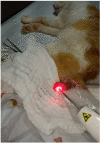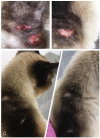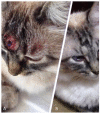Laser therapy in the treatment of feline sporotrichosis: A case series
- PMID: 37146090
- PMCID: PMC10153455
- DOI: 10.29374/2527-2179.bjvm005822
Laser therapy in the treatment of feline sporotrichosis: A case series
Abstract
Sporotrichosis is the most prevalent subcutaneous mycosis in Latin America and is an important zoonosis in expansion throughout all the brazilian territory. Domestic cats are highly susceptible to the disease and play an important role in the spread of the agent to both other animals and humans. Sporothrix brasiliensis, the predominant species in the country, has greater virulence and some isolates also showed resistance to azoles, the class of antifungals of choice for treatment. Because it is a long-duration treatment, of high cost, and oral use, sick animals are often abandoned, which contributes to the spread and permanence of the infection as an important public health problem. Therefore, new therapeutic alternatives or adjuncts to treatment with antifungals may contribute to combating this zoonotic agent. In this work we describe the result of the treatment with laser therapy of eight Sporothrix spp infected cats. Our findings show the efficacy of the laser treatment even in different clinical forms. This technique has the potential to decrease the time length and costs of conventional treatment as well as the improvement of the treatment results.
A esporotricose é a micose subcutânea de maior prevalência na América Latina e se apresenta como uma importante zoonose em expansão por todo território brasileiro. Os gatos apresentam grande suscetibilidade à doença e assumem importante papel na disseminação do agente tanto para outros animais quanto para humanos. O Sporothrix brasiliensis, espécie predominante no país, apresenta maior virulência e alguns isolados também apresentaram resistência aos azóis, classe de antifúngicos de escolha para o tratamento. Por ser um tratamento de longa duração, de alto custo e de apresentação de uso oral, é frequente o abandono dos animais doentes, o que contribui para a disseminação e permanência da infecção como um importante problema de saúde pública. Sendo assim, novas alternativas terapêuticas ou coadjuvantes do tratamento com antifúngicos podem contribuir para o enfrentamento deste agente zoonótico. Nesse trabalho descrevemos os resultados obtidos no tratamento com a laserterapia em oito casos de gatos infectados por Sporothrix spp. Nossos achados mostram a eficácia do tratamento com laser mesmo em diferentes formas clínicas. Essa técnica tem o potencial de diminuir o período de tempo e os custos do tratamento convencional assim como melhorar os resultados do tratamento.
Keywords: Sporothrix brasiliensis; alternative therapy; laser; mycosis.
Conflict of interest statement
Conflict of interest: No conflict of interests declared concerning the publication of this article.
Figures









References
-
- Almeida-Paes R., Oliveira M. M. E., Freitas D. F. S., Dovalle A. C. F., Gutierrez-Galhardo M. C., Zancopé-Oliveira R. M. Refractory sporotrichosis due to Sporothrix brasiliensis in humans appears to be unrelated to in vivo resistance. Medical Mycology. 2017;55(5):507–517. - PubMed
-
- Barros M. B. L., Schubach T. M. P., Galhardo M. C., Schubach A. O., Monteiro P. C. F., Reis R. S., Zancopé-Oliveira R. M., Lazéra M. S., Cuzzi-Maya T., Blanco T. C. M., Marzochi K. B. F., Wanke B., Valle A. C. F. Sporotrichosis: Na emergente zoonosis in Rio de Janeiro. Memorias do Instituto Oswaldo Cruz. 2001;96(6):777–779. doi: 10.1590/S0074-02762001000600006. - DOI - PubMed
-
- Borba-Santos L. P., Rodrigues A. M., Gagini T. B., Fernandes G. F., Castro R., De Camargo Z. P., Nucci M., Lopes-Bezerra L. M., Ishida K., Rozental S. Susceptibility of Sporothrix brasiliensis isolates to amphotericin B, azoles, and terbinafine. Medical Mycology. 2015;53(2):178–188. doi: 10.1093/mmy/myu056. - DOI - PubMed
-
- Del Carlo R. J., Rodrigues C. B. S., Natali A. J., Monteiro B. S., Del Carlo K. N., Limonge C. R. Terapia laser de baixa potência (4nm) na reparação de defeito osteocondral experimental da cabeça umeral de cães. Revista Ceres. 2007;54(311):73–79.
Publication types
LinkOut - more resources
Full Text Sources
Miscellaneous
